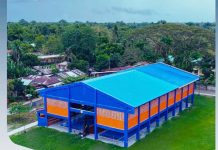PALO, Leyte- It’s Leyte’s turn to drumbeat its destinations to tourists.
The campaign, dubbed as “Pasyada ha Leyte,” was formally launched last April 28 at the Pag-Ibig Plaza attended by Leyte Governor Leopoldo Dominico “Mic” Petilla and Palo Mayor Remedios “Matin” Petilla. During the said launching, the province-wide program aims to boost Leyte’s agriculture sector still reeling from the aftermath of supertyphoon “Yolanda” was also rolled out known as the “More Income in the Countryside” or MIC. The “Pasyada ha Leyte” is part of a campaign of the Department of Tourism to entice tourists to visit Leyte, particularly to destinations of the province that are slowly becoming favorite among tourists.
Among the tourist attractions that were included in the package were the Kalanggaman Island, known for its white beach and sand bar located in Palompon; the geothermal plant and pineapple plantation in Ormoc City; the century-old houses in Baybay City as well as the Palo Cathedral, the Archbishop Palace and the MacArthur National Shrine, all in Palo, among others. Palo town Mayor Petilla said that the “Pasyada ha Leyte” signifies that the province is now back to business, ready to welcome tourists expected to flock to its various tourist destinations.
Petilla, who was once the chair of the Regional Tourism Council when she was the governor of Leyte, said that after the province was pummeled by Yolanda, it’s about time that it rose again with tourism among the engines towards recovery. She added that through the program, prospective tourists could see for themselves the beauty of Leyte.
Meantime, during the same gathering, Gov.Petilla led in the launching of the MIC agri- fair. According to him, the agri- fair will be a good showcase of the resiliency of the Leyteños getting back to their feet after their harrowing experienced due to Yolanda, considered the world’s strongest typhoon to make landfall.
Petilla said that the province’ agriculture sector need to be provided ample assistance considering that it was the most devastated sector. Leyte, he said, was one of the country’s top agricultural provinces before it was struck by Yolanda. Petilla recalled that when a representative from the World Food Program (WFP) visited the command center in Palo five days after the massive storm, two things came into his mind, the rice and coconut industry of the province.
So by the end of November 2013, the different government agencies and WFP pooled their resources together to buy 63,000 sacks of rice seeds for the farmers. By May, 2014, the Department of Agriculture reported a bumper harvest which was very unusual but which was most welcomed by the province. “We also go into compact farming, from 38 farmers before Yolanda, now we have trained 2,500 farmers in high-valued crops,” Petilla said. “We continue to train until the 1,394 barangays in Leyte will be included, which is one way of getting our people out of poverty,” he added. (VICKY C.ARNAIZ)



